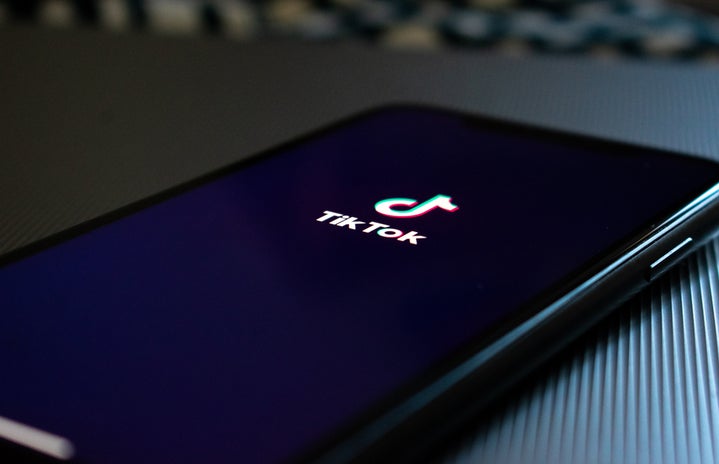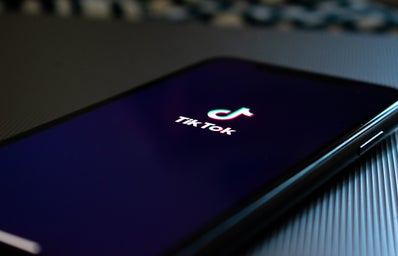In the middle of campus stands a tall and proud oak tree. Its branches stretch up into the sky like it’s doing yoga. The mid-autumn winds rustle the vibrant yellow leaves. Jacqui Patterson sees this tree from her dorm room window in Dunbar Hall every time she sets her phone on the window sill. This is where she films her TikToks.
She opens the app and presses a couple of buttons. A timer starts counting down from ten as Jacqui stands in frame of the camera, smoothing down her clothes and fixing her hair. 3…2…1…an upbeat song blasts out of her phone and she jumps around to the music. Within fifteen seconds, it’s over and Jacqui grabs her phone to watch what she just recorded.
TikTok came to fruition in late 2016 after creators rebranded an old video sharing app called Musically. TikTok gives anyone who makes an account a platform for creating and sharing short videos that have the potential to garner thousands, sometimes even millions, of views, likes and shares.
Jacqui is just one of many creators on the app to have amassed thousands of followers through posting content. The app gives its users the ability to make funny videos and comedy sketches or show off their talents — like singing, painting, dancing — to almost a billion users. Videos go viral faster than users can make them.
After initially downloading the app to watch one of her friend’s TikToks, Jacqui soon became fascinated with the whole idea of TikTok. After making an account and posting a couple of videos, that was it. Other aspects of her life like school and work became more important than mindlessly scrolling through the app. She continued casually posting fun videos whenever an idea struck her mind, but nothing too thought out.
Then all of a sudden, one of her videos had been liked by a couple thousand people. The view count was similar to the likes. Just like that, a steady stream of people started following her until she quickly surpassed one thousand followers. Now, she has 36,000 followers and over 830,000 likes.

At first, she was overwhelmed. Did this mean that she was “famous”? And how do you even define fame in the context of TikTok? There are people with millions of followers who, if you didn’t know they had an account on TikTok, do not seem famous to the public at all. The niche intersection of fame and TikTok is as intriguing as it is confusing.
Ironically, the video of hers that blew up was her addressing the fact that of her pre-‘fame’ followers (around 120), most were very young girls around nine years old. After that video garnered 20,000 likes, more young girls followed her.
TikTok requires its users to be at least 13 years old to make an account, and anyone under 18 must have parental permission to join the app. However, when setting up their account, kids under 13 just changed their birth year so it said they were over 13. Earlier this year, TikTok agreed to pay over five million dollars to the FTC to settle accusations that it was in violation of the Children’s Online Privacy Protection Act, which requires apps seek parental approval for users under 13 years old. Despite this settlement, young kids still find loopholes.
In October of this year, an elementary school in South Carolina asked its fourth graders to raise their hands if they use TikTok. A quarter of the nine-year-olds raised their hands.
While TikTok does not allow mature, R-rated content, users often insinuate inappropriate things in their videos that kids likely would not understand at first. Because of this, kids under 13 are being exposed to mature content maybe even for the first time in their lives.
“Now that I have a little bit of a following,” Jacqui modestly said, “I am more aware of the content that I post, and I don’t want to spam or post stupid things anymore. I have to be careful and cautious about what I post because they’re all kids.”
Certain aspects of Jacqui’s personality, like how she cusses like a sailor, had to be changed in her TikTok videos because she doesn’t want her young followers to see that and think it’s okay for them to act the same way.
It’s still something she struggles with to this day.
“Sometimes I think I’m changing my personality too much,” she said. “I want to be able to make content without having to worry about who is seeing it. I want to be able to make content for people that would actually enjoy like my normal self, but I know that isn’t nine-year-old girls. However, that is still most of my fan base.”
An appealing part of the app is the ability for users to make money. While TikTok does give users the ability to send monetary gifts to other users, it really is not a viable option in Jacqui’s eyes. Users have to purchase coins, which cost anywhere from $1.29 to $134.99 depending on the number of coins a user wants. The $1.29 option is for 100 coins. Those coins can then be used to purchase gifts, the cheapest costing 5 coins. Users then give their gifts to their favorite creator during the creator’s live streams, when they broadcast themselves out to their fans. Once the gifts are received, they are transferred into diamonds. The value of the diamonds is based on the standards TikTok sets, which change often.
Jacqui currently has 7,490 diamonds, which transfers into $37. You have to have a minimum of $100 to cash out.
Despite everything, Jacqui makes TikToks because it’s fun.
Jacqui is a zoology major at Kent. Her TikTok experiences can’t really transfer over to that field as well as an acting or film major’s could. She won’t get a job from TikTok, and she certainly won’t ever be able to have TikTok be her main source of income. But despite everything, Jacqui is still making videos.
“It’s more like a side hustle to me,” she said. “Because there’s the small opportunity for money and it’s a creative outlet that you can do for fun instead of stressing about school. I really enjoy the community aspect of the app as well. I like being able to have my followers come together during my live streams to connect with each other.
“In the end, it makes it all worth it.”




